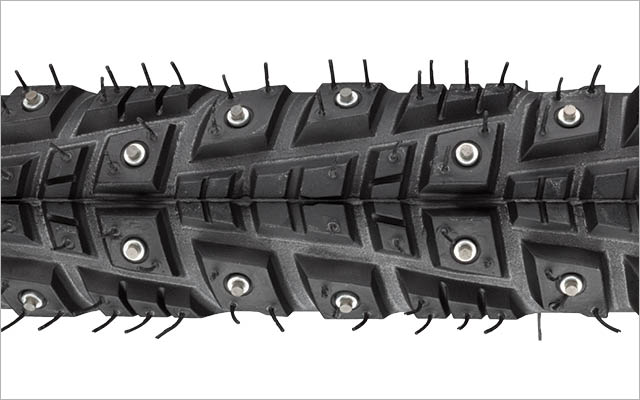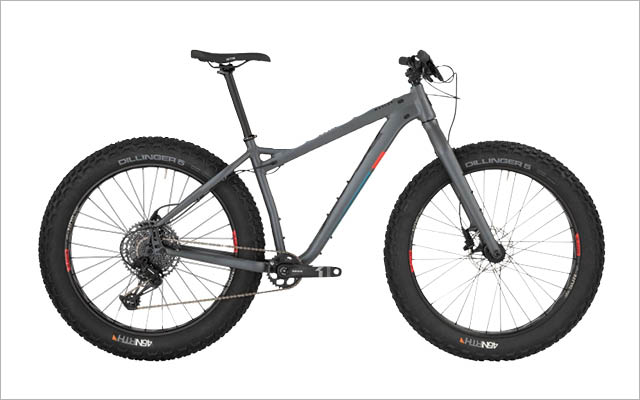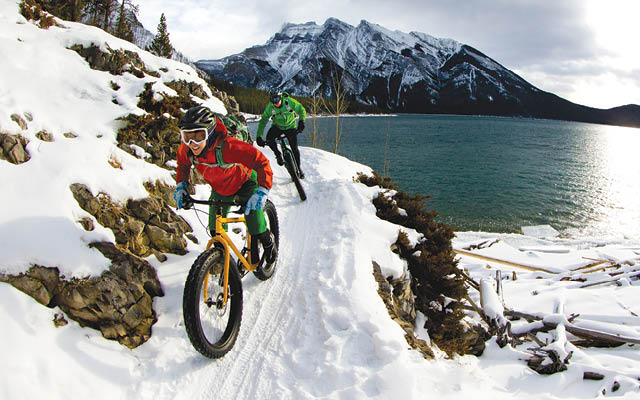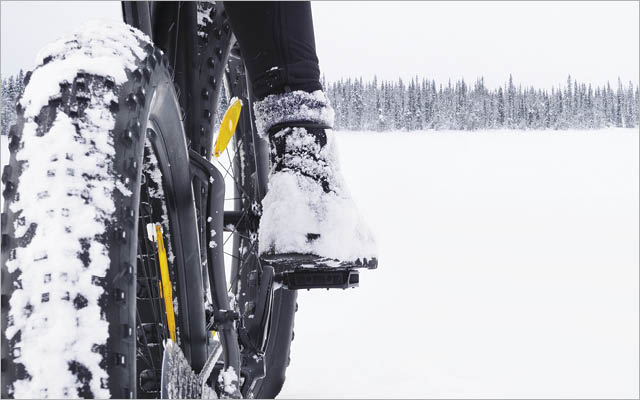Once upon a time, people parked their bikes while hibernating during the snowy months and dreamed sad dreams of the joys of riding. Those days are history, thanks to two modern innovations: studded tires that can be swapped onto most bicycles for snowy treks, and fat-tired bikes that allow us to scoff at winter’s supposed hazards.
The old “off-season” is now one of the best seasons to ride.
Just ask Alexandera Houchin, all-round extreme bicyclist. Among other races, she’s won the 2,745-mile Tour Divide from Canada to Mexico over the Continental Divide — twice, that is, in 2018 and 2019 — and been labeled a “force of nature” in ultra-endurance racing. A citizen of the Fond du Lac Band of Lake Superior Chippewa in northern Minnesota, she’s also a devotee of winter biking.
“I appreciate winter cycling as a means of transportation, for sure,” Houchin says. She’s a confirmed year-round commuter and exerciser, and a former bike messenger.
But along with snowshoeing and cross-country skiing, she loves just getting out in the winter wonderland and ripping. “The solitude of biking on a snowy single-track trail is magical.”
Many snow-laden cities now boast miles of well-kept bike paths and separated bike lanes; groomed off-road trails are carved through parks and forests. And winter bikers know these routes are often plowed before car lanes — and they stay clearer, because they’re not encumbered by salt or chunks of snow.
Best of all, much of the time you’ll have these routes to yourself — or enjoy a sense of camaraderie among the other winter riders you do meet.
Those two innovations mentioned earlier? They offer different ways to get through the snow.
Winter tires feature knobby treads (for dealing with the white stuff) and steel studs (to get a grip on ice and other slippery terrain). You can fit studded tires onto your summer ride or buy a cheapo second bike to use only in the winter.
Single-speed, cyclocross, and mountain bikes are ideal. These skinnier-tired bikes knife through snow — but they can get bogged down in snow deeper than the bottom bracket.
Fat-tired bikes come with or without studded tires. They compress and ride atop the snow . . . most of the time. They too can get stuck in deep drifts, and then they’re a workout just to push.
“Winters make us all a little tougher,” says Houchin. “One way to get through the season is to really get outside and appreciate it. Cold weather isn’t bad, it’s invigorating. If we can thrive — and not simply endure — in the wintry bliss, we come out stronger.”
Technique Tips & Drills
Sort Your Ride
Certain bikes work better in certain conditions, says Houchin. “Fat biking on trails can be utterly mystical. It’s almost like you’re flying in the clouds. The trees rush past faster than if you were on snowshoes or skis. But having a fat bike doesn’t mean you can ride through any type of snow: Trails need to be groomed or plowed.”
For commuting, many riders opt for single-speed bikes, because they have less drivetrain to get clogged or rusted with snow and salt. Houchin prefers the Jedi approach — a fixed-gear bicycle (with her legs providing the braking power via backpedaling, allowing her more control).
And she swears by studded tires. “Studded tires are wondrous — ice hides in the sneakiest places, and fat-bike tires are slippery when not studded. Also, slushy, soggy days call for a fully fendered bike, which is easier to do on a regular ol’ steel junker.”
If you have to deal with ice, studs are as essential as mittens. Less-expensive tires feature steel studs, which wear out — and rust — more quickly. Better tires use carbide tips. And with studs, you can even feel safe riding across a frozen lake.
Either way, eschew clip-in pedals; keep your feet free for when you start to slide out.
Traction vs. Stability
With studded tires, bicycles often boast better traction than even all-wheel-drive cars, trucks, or SUVs. But because you have only two wheels, you have only half the stability — and narrower tires probably subtract even more.
The key to countering this is balance. Ride with your derrière positioned well back over your bike’s weight-center to keep both your wheels planted. And don’t lean too far over the handlebars: Going uphill, your rear wheel will lose traction and spin out. And if you strike deep snow, you could end up taking flight over the bars.
If you can afford only one studded tire (they’re more expensive than regular tires), fit it to your front wheel: You want the security of good grip, while your rear wheel, with all the power going to it, is bound to slide a bit no matter how balanced you are.
Finally, ride relaxed. “Let the bike find its path forward and do little micro-corrections as you go,” advises pro mountain-bike racer Selene Yeager, author of numerous cycling books.
Winter biking isn’t about muscle: It’s about that balanced, relaxed stance, and an adventurous frame of mind.
Cross-Training
Like running in sand, riding in snow requires more energy — gobs more. Houchin prepares by cross-country skiing and snowshoeing, as well as bike riding and racing throughout the balmy months.
Conversely, she uses winter biking to ready herself for summertime jaunts like the Tour Divide.
“I am a huge fan of HIIT [high-intensity interval training],” she says. “I write a list of 10 exercises — burpees or jumping jacks, for example — and set a timer with one minute ‘on’ and 40 seconds rest. I do as much of the first exercise on the list as I can in the minute, then repeat with the next exercise.” (For a HIIT workout, see “The 6-Minute Sweat Workout”.)
Dress for Success
As the wise old saying goes, there’s no such thing as bad weather, just bad gear.
“If you’re going trail riding, dress in layers: You get hot real quick while pushing hard to climb on your snow bike,” says Houchin. “Do a five-minute warm-up near your car or house and if you feel warm enough, ditch a layer before you hit the trail. Even better, bring a backpack to stuff layers into.”
When you dress, think of the outdoors being 20 degrees warmer than it is; start out riding feeling ever-so-slightly cold.
And there’s no right or wrong way: Many winter bikers make their own hacks for gear, from custom-building winter bikes to assembling the weatherproof clothing that suits them.
“You don’t need fancy gear to ride your bike in the winter,” says Houchin. “Get some flat pedals [without clips], wear your snow boots, and ride!”
Winter-Biking Gear Essentials
45NRTH STUDDED TIRES

Look for the widest tire you can fit on your bike by checking fork, rear-stay, and brake clearance, then seek out the tire with the most carbide-steel-tipped studs. $60 and up from bike shops. Info at www.45nrth.com.
FROST RIVER CHOPPER MITTENS

There are gloves specially made for winter riding, but nothing will keep you as warm as old-fashioned choppers. Frost River’s buckskin outers combined with wool liners are time-proven champs. From $65 at www.frostriver.com.
SALSA MUKLUK SK EAGLE FAT BIKE

With 12 gears and 80 mm tires, it’s ideal for all sorts of wintry explorations. Also available in a pricier, racier carbon version. $1,999 from Salsa dealers; more info at www.salsacycles.com/bikes/mukluk.
This originally appeared as “Biking in a Winter Wonderland” in the December 2020 print issue of Experience Life.




This Post Has 0 Comments